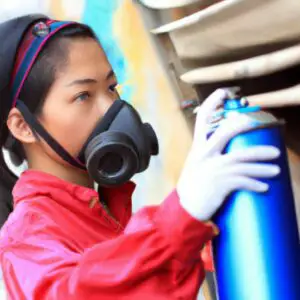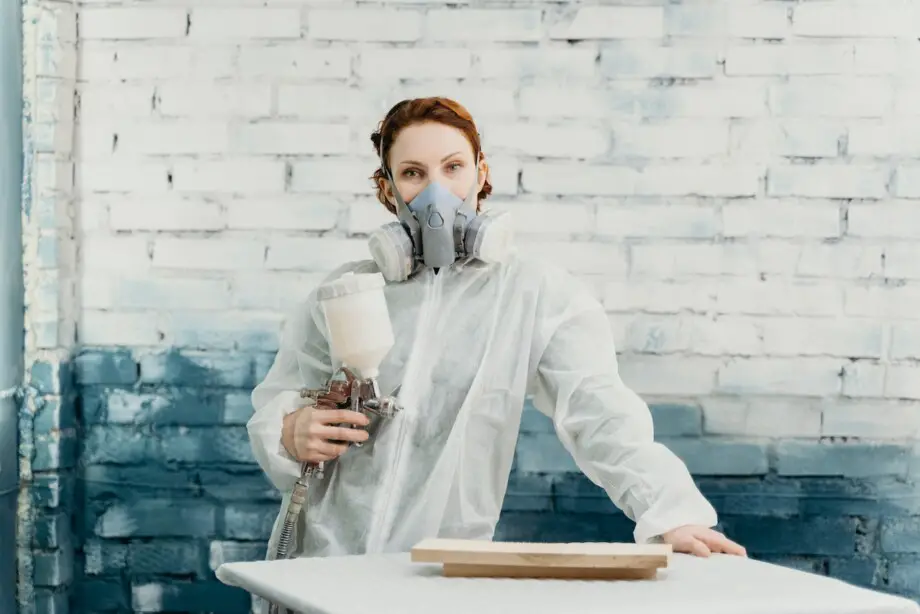Easy to use, fast drying, and even finish, isn’t this every DIY painter’s dream?
And that exactly is the hype about spray paints!
You press a nozzle; you have a fine mist of paint that coats your surfaces smoothly, and viola!
The aerosol cans make painting oh-so-easy.
However, with great convenience comes great responsibility. And that’s when the biggest concern arises: can spray paints cause cancer?
To answer your question right away, here is what we know about spray paints causing cancer:
Spray paints may and may not cause cancer, depending on the composition of the aerosol paints. Various studies have been conducted to find the effects on the health of occupational painters. However, it is important to note that spray paints do possess health threats in some way or the other way.
Below is a detailed overview of if spray paints can cause cancer. Read on to learn more before you dive into your next DIY project.
A Brief Overview of Spray Paints
Spray paints come in a canister and are applied using a spray nozzle. They are designed to be used on various surfaces, such as metal, wood, plastic, and fabric.
Whether you need to revamp your old car or revitalize your wardrobe by painting denim, spray paints are a popular choice for both professionals and DIY enthusiasts due to their convenience and versatility.
How Do the Aerosol Cans Work
Spray paints contain liquefied paint and a propellant gas, typically compressed air or liquefied gas.
When you press the can nozzle, the air pressure in the can changes transforming the gas and paint into tiny droplets. These droplets are sprayed out in fine mist. The mist then settles onto the surface, creating an even and smooth finish.
But as we all know, this sprayed mist also releases paint fumes, which many people think are carcinogenic.
Before diving into the conclusion, it is important to know what exactly in the aerosol can is responsible for causing cancer.
The Chemical Composition of Spray Paints
The chemical composition of spray paints can vary depending on the specific brand and type of paint. However, most spray paints contain the following basic components:
- Pigments: These are the particles that provide color to the paint. Pigments can be organic or inorganic.
- Resins: These are the binding agents that hold the pigments together and help the paint adhere to surfaces.
- Solvents: These liquids help dissolve the resins and pigments and keep the paint in a liquid form. Solvents in spray paints are usually volatile organic compounds (VOCs), which can harm human health.
- Propellants: These are the gasses that create pressure to force the paint out of the can. Common propellants in spray paints include butane, propane, and dimethyl ether.
- Additives: Additives improve paint’s performance, such as drying time, viscosity, and resistance to weathering.
The Link between Spray Paint and Cancer
The potential carcinogenic effects of spray paint are thought to be due to the presence of volatile organic compounds (VOCs), heavy metals, and isocyanates. These chemicals release into the air when you spray the pain.
When inhaled, spray paint fumes’ side effects can be severe. They can enter the lungs and respiratory system, where they can cause irritation, inflammation, and damage to delicate tissues and cells. Over time, this damage can accumulate, increasing the risk of developing cancer.
Several types of cancer have been associated with spray paint exposure, including lung cancer, bladder cancer, kidney cancer, and leukemia.
Research studies have provided evidence to support the link between spray paint and cancer.
Below are some studies discussed:
- A study was conducted on a 46-year-old non-smoking bumper spray painter who developed lung cancer after 15 years of work. Experts found high levels of hexavalent chromium in bright yellow paint and consider it a possible suspect in the crime.
- Another study found that men who have worked as painters at some point have a higher chance of getting lung cancer than men who have not worked as painters. This increased risk was the highest for painters who worked in construction and repair. They have an increased risk of lung cancer, including small and squamous cells. The risk is higher for men who have smoked and also worked as painters.
- A case-control study was conducted in Northern Italy to assess the relationship between bladder cancer, occupation, and exposure to occupational agents. The study found that, along with other occupations, people associated with painting/spraying work reported more frequent cases of bladder cancer.
- Comprehensive data available online discusses in detail the types of cancer and the chemicals responsible for causing the disease. Some of the cancers mentioned in the data are lung, bladder, and childhood leukemia associated with maternal or paternal paint exposure. There are inconclusive data on cancers of the upper aerodigestive tract (oral cavity, nose, pharynx, nasopharynx, larynx, and esophagus), stomach, pancreas, liver, colon, rectum, kidney, brain, prostate, testis, ovary, and breast, and of melanoma and soft–tissue sarcoma. Some chemicals known or suspected to cause cancer are Benzene, Formaldehyde, Toluene, Xylene, Ethylbenzene, Cadmium, and Lead.
Can Spray Paints Cause Cancer?
Not all spray paints cause cancer, but some may contain harmful substances known as carcinogens. The risk of developing cancer from exposure to these substances depends on the level and duration of exposure, as well as individual factors such as age, health status, and genetic makeup.
Occupational exposures to spray paint are particularly concerning, as workers in industries such as painting, automotive repair, and construction may be exposed to high levels of spray paint fumes regularly.
However, if you are using spray paint for personal projects at home, you may be safe with proper precautions to protect yourself from exposure.

Preventing Exposure to Spray Paint
Let’s be honest – a little DIY project every once in a while won’t cause much harm and will satisfy your painting cravings.
To minimize exposure to potentially carcinogenic chemicals in spray paint, you MUST take the following precautions.
- Work in a well-ventilated area to allow fumes to disperse and minimize inhalation of toxic chemicals.
- Wear appropriate protective gear, such as a respirator mask and gloves, to minimize skin and respiratory exposure to VOCs.
- Use spray paint that contains low levels of VOCs and follow the manufacturer’s instructions for safe use.
- Take breaks when working with spray paint to allow the fumes to dissipate.
- Avoid working in enclosed spaces where fumes can accumulate.
What Happens if You Inhale Spray Paint Fumes
Inhaling spray paint fumes can be dangerous to your health. Symptoms of spray paint poisoning include headaches, dizziness, nausea, coughing, wheezing, and shortness of breath.
If you have accidentally inhaled spray paint fumes, here are some steps you can take:
- Move to a well-ventilated area: If you are indoors, go outside or open windows and doors to get some fresh air. This can help to reduce the concentration of fumes you are breathing in.
- Seek medical attention: If you are experiencing any symptoms such as dizziness, nausea, or difficulty breathing, seek medical attention immediately. Call your local emergency number or go to the nearest emergency room.
- Drink plenty of water: Drinking water can help to flush out any chemicals that may have entered your system.
- Rest: If you feel lightheaded or dizzy, lie down and rest until you feel better.
- Take precautions in the future: When working on future projects, make sure to work in a well-ventilated area and wear a mask or respirator to protect yourself from inhaling fumes.
Frequently Asked Questions (FAQs)
Can I get cancer from spray paint?
Yes, prolonged exposure to spray paint fumes can increase the risk of cancer.
What kind of cancer does paint cause?
Spray paint exposure can increase the risk of lung, liver, and bladder cancer.
How long is spray paint fumes harmful?
Spray paint fumes can be harmful for several hours after painting or up to a day after the paint is dried. Proper ventilation and air filtration can help to disperse the fumes quickly.
What are the dangers of spray paint?
The dangers of spray paint include respiratory problems, liver and kidney damage, and an increased risk of cancer.
How to clear the lungs of spray paints?
The best way to clear your lungs of spray paint is to seek medical attention and follow the advice of a healthcare professional. Also, follow the steps discussed above.
Can acrylic paint cause cancer?
Acrylic paint does not contain the same harmful chemicals as spray paint and is generally considered safe to use.
What to do after inhaling paint fumes?
If you think you’ve inhaled spray paint fumes, go in a well-ventilated area, drink plenty of water, take rest, seek medical help if the symptoms feel worse, and make sure to follow precautions next time you spray paint.
Conclusion
In conclusion to the query Can Spray Paints Cause Cancer, here’s our takeaway: Spray paint can cause health hazards, including the risk of cancer. It is crucial to take appropriate measures to protect yourself from exposure. Understanding the hazards and risks of spray paint is essential for minimizing exposure and controlling the associated risks. By following safety guidelines and taking appropriate precautions, you can enjoy spray paint’s benefits without risking your health.Want to know how you can take your spray painting projects to the next level? We have compiled just the right content for all YOUR needs! Spray paint your cars, renovate your homes and bathrooms, and upscale your wardrobe with everything you need to know.


